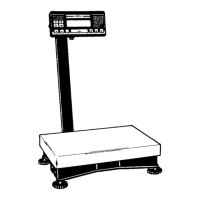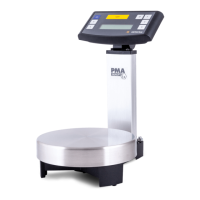Do you have a question about the Sartorius QC15DCE-S and is the answer not in the manual?
Overview of the electronic scale features and capabilities.
Instructions for removing the transport locking device before operation.
Describes the intended applications for the QC series counting scales.
Recommendations for setting up the scale in suitable ambient environments.
Notes for QC models verified for use in legal metrology, including warm-up.
Guidelines for operating the scale in hazardous areas according to regulations.
Details on suitability for Zone 2, Group II hazardous areas within the EC.
Unpacking and initial setup procedures for QC 7 models.
Instructions for mounting the display unit using optional hardware.
Steps for leveling the scale using the integrated level indicator.
Information on using the display as a remote unit with optional holder.
Detailed steps for disassembling and mounting the display on the long side.
Details on the initial verification process by authorized service representatives.
Requirements for auxiliary measuring devices used with the scale in legal metrology.
Ensuring correct voltage and AC adapter compatibility for scale operation.
Specific instructions for connecting power in Zone 2 hazardous areas.
Important safety notes regarding the AC adapter's electrical rating and grounding.
Explanation of CE marking requirements and Sartorius' compliance.
Details on Council Directive 89/336/EEC regarding electromagnetic compatibility.
Explanation of Council Directive 73/23/EEC for electrical equipment safety.
Information on the directive governing non-automatic weighing instruments and legal metrology.
Information regarding the declaration of type conformity for weighing instruments.
Information about the EC Type-Approval Certificate, its validity, and revisions.
Description of the new installation service including installation, startup, and training.
Explanation of calibration versus adjustment and their purpose for accuracy.
Guidelines on using calibration weights with accuracy equal to or better than the scale.
Procedures for connecting external devices like printers or PCs to the scale.
Solutions for problems like missing display segments or incorrect weight readouts.
Troubleshooting steps for issues with scale stabilization and calibration.
How to adapt scale settings to ambient conditions and specific requirements.
Steps involved in selecting and changing menu codes for specific functions.
Detailed steps for turning the scale on and accessing the operating menu.
How to confirm and store new menu code settings, including the self-test function.
Using the reset function to restore all menu codes to original factory settings.
Adjusting scale settings to prevailing ambient conditions for optimal performance.
Procedures for external calibration and linearization using specific menu codes.
Defining parameters for data output, including print request and auto print.
Introduction to the various application programs and their usage.
Program for checking net weights against defined tolerance ranges.
Program for checking weight variations against tolerance limits.
A step-by-step example for checking net weights using the scale.
Example of using checkweighing and counting programs together.
Example of checking weight variations specifically by piece count.
List and explanation of error codes indicating operating or routine errors.
Introduction to the scale's interface port for connecting to computers or devices.
Notes on electrical connections and potential interference when interfacing devices.
Technical specifications for QC34/64 EDE-S and other related models.
Technical specifications for QC7 CCE-D, QC34 EDE-D, and QC64 EDE-D models.
Technical specifications for QC7 CCE-S0CE, QC34 EDE-S0CE, and QC64 EDE-S0CE models.
Technical specifications for QC7 CCE-L0CE, QC34 EDE-L0CE, and QC64 EDE-L0CE models.
Performance specifications for various QC DCE, EDE, FEG, and FES models.
List of external calibration weights with accuracy classes and order numbers.
Step-by-step instructions for setting and confirming menu codes.
Steps for performing external adjustment and calibration using code 1 9 1.
Instructions for external linearization using code 1 9 5.
Summary of menu codes for ambient conditions, weighing, and filling modes.
Menu codes for various application programs like counting, tare memory, and checkweighing.
Overview of the electronic scale features and capabilities.
Instructions for removing the transport locking device before operation.
Describes the intended applications for the QC series counting scales.
Recommendations for setting up the scale in suitable ambient environments.
Notes for QC models verified for use in legal metrology, including warm-up.
Guidelines for operating the scale in hazardous areas according to regulations.
Details on suitability for Zone 2, Group II hazardous areas within the EC.
Unpacking and initial setup procedures for QC 7 models.
Instructions for mounting the display unit using optional hardware.
Steps for leveling the scale using the integrated level indicator.
Information on using the display as a remote unit with optional holder.
Detailed steps for disassembling and mounting the display on the long side.
Details on the initial verification process by authorized service representatives.
Requirements for auxiliary measuring devices used with the scale in legal metrology.
Ensuring correct voltage and AC adapter compatibility for scale operation.
Specific instructions for connecting power in Zone 2 hazardous areas.
Important safety notes regarding the AC adapter's electrical rating and grounding.
Explanation of CE marking requirements and Sartorius' compliance.
Details on Council Directive 89/336/EEC regarding electromagnetic compatibility.
Explanation of Council Directive 73/23/EEC for electrical equipment safety.
Information on the directive governing non-automatic weighing instruments and legal metrology.
Information regarding the declaration of type conformity for weighing instruments.
Information about the EC Type-Approval Certificate, its validity, and revisions.
Description of the new installation service including installation, startup, and training.
Explanation of calibration versus adjustment and their purpose for accuracy.
Guidelines on using calibration weights with accuracy equal to or better than the scale.
Procedures for connecting external devices like printers or PCs to the scale.
Solutions for problems like missing display segments or incorrect weight readouts.
Troubleshooting steps for issues with scale stabilization and calibration.
How to adapt scale settings to ambient conditions and specific requirements.
Steps involved in selecting and changing menu codes for specific functions.
Detailed steps for turning the scale on and accessing the operating menu.
How to confirm and store new menu code settings, including the self-test function.
Using the reset function to restore all menu codes to original factory settings.
Adjusting scale settings to prevailing ambient conditions for optimal performance.
Procedures for external calibration and linearization using specific menu codes.
Defining parameters for data output, including print request and auto print.
Introduction to the various application programs and their usage.
Program for checking net weights against defined tolerance ranges.
Program for checking weight variations against tolerance limits.
A step-by-step example for checking net weights using the scale.
Example of using checkweighing and counting programs together.
Example of checking weight variations specifically by piece count.
List and explanation of error codes indicating operating or routine errors.
Introduction to the scale's interface port for connecting to computers or devices.
Notes on electrical connections and potential interference when interfacing devices.
Technical specifications for QC34/64 EDE-S and other related models.
Technical specifications for QC7 CCE-D, QC34 EDE-D, and QC64 EDE-D models.
Technical specifications for QC7 CCE-S0CE, QC34 EDE-S0CE, and QC64 EDE-S0CE models.
Technical specifications for QC7 CCE-L0CE, QC34 EDE-L0CE, and QC64 EDE-L0CE models.
Performance specifications for various QC DCE, EDE, FEG, and FES models.
List of external calibration weights with accuracy classes and order numbers.
Step-by-step instructions for setting and confirming menu codes.
Steps for performing external adjustment and calibration using code 1 9 1.
Instructions for external linearization using code 1 9 5.
Summary of menu codes for ambient conditions, weighing, and filling modes.
Menu codes for various application programs like counting, tare memory, and checkweighing.











